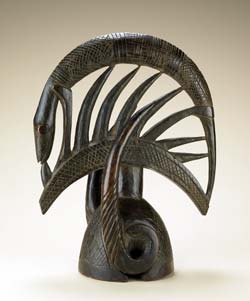
The standard cartoon of a chameleon shows it changing color--from green to red to plaid.
In Africa the message is more complex. The chameleon is a common symbol of transformation. Such power can be harnessed both by the witch, one who causes harm, and the witch hunter, one who protects (healer, diviner or ruler). Visually, this concept is expressed by changing form as well as color. The Yoruba kola nut box, for instance, depicts a chameleon transforming into a leopard.
 Many African peoples find the chameleon's ability to eventually reach its destination noteworthy. Asante proverbs and weights extol this feature, as do the Senufo peoples who say "the chameleon walks as though present at the creation of the earth when the ground was soft and shook." Many African peoples find the chameleon's ability to eventually reach its destination noteworthy. Asante proverbs and weights extol this feature, as do the Senufo peoples who say "the chameleon walks as though present at the creation of the earth when the ground was soft and shook."
This sense of balance is also shown in the wood headdress an Afo drummer wears at the funeral of a noble or important village elder. A chameleon rests atop a rooster's comb, which refers to the drummer who is called ekpeshi or featherman. Antelope horns are also visible on the sides of the headdress. (2005-6-175)
A chameleon's tail curls into a spiral, which is an important symbolic motif for life and the passage of time. Somewhat mystifying, however, is the direction in which the curled tail is pointed-in art the tail is up, in nature it is down.
|